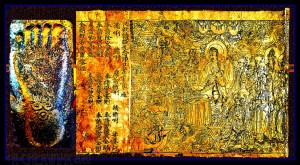In researching this, one will find that there are today literally legions of translations on this majestic body of work. Each of these translations, by and large, is a hodgepodge of former adaptations over the years with an added dose of the compilers variable traditions. I have chosen to compile this attempt with renditions ranging from Conze and Muller, to Mu Soeng and even more esoteric distinctions.
The Vajrachchedika Prajnaparamita, or Diamond-Cutter Sutra
Great obeisance to the blessed Ârya-prajñâ-pâramitâ (perfection of Noble Wisdom)
One: The Convocation of the Assembly
Thus have I heard. At one time the Blessed One was staying at the Anathapindika’s garden in the Jeta Grove in the city of Shravasti. With him was a large gathering of 1,250 monks and Bodhisattva-Mahasattvas. Early in the morning, when the meal time arrived, the Blessed One put on his robe and, holding his bowl, entered the great city and began to beg for food. Having finished begging from door to door, he came back to his own seat in the garden and consumed his meal. When this was completed, he put away his robe and bowl, washed his feet, spread his seat, and sitting-down mindfully centered his attention in front of him.
Thus have I heard: this is the traditional opening conventional-line that is appended at the beginning of all Sutra Literature. Its origins trace back to the first Council of the Buddhaic Elders that was convened at Vulture Peak. This could be considered comparable to what transpires in the Catholic-world wherein Cardinals and Bishops and other ecclesiastical dignitaries convene a Council over Doctrinal matters; although, in light of the Buddhadharma, something even more spiritually-pronounced and profound occurred as the august assembly of the Buddha’s disciples gathered to discern the Divine Will of the Sugata through mystical hearing—Dhammasota—the actual Buddha-gnosis as conveyed from the Deathless Mind of the Sugatagarbha. Thus, at that first Buddhaic Council, beloved Ananda (Buddha Shakyamuni’s first cousin)—who was born at the precise moment that Buddha Gautama Self-realized Anuttara Samyak Sambodhi beneath the Sacred Bodhi-Tree—relayed to the convocation how he once asked the Blessed One, before he departed for parinirvana, what his desire was for how such an assembly was to be invoked; the Buddha replied, “Thus have I heard.”
The Blessed One: the Buddha, also referred in many translations as Bhagavat—the Blessed One. The Supreme Awakened One who has thrown-off the shackles of all defiled sensate phenomena and who now eternally basks in the Primordial Salvific-Light of the Unborn Buddha Mind.
Anathapindika’s garden in the Jeta Grove: tradition has it that Anathapindika was a rich banker who procured the Buddha’s “meditation garden” from Prince Jeta, a descendent of a local kingdom. The story goes that the Prince would allow this provided that they completely “fill the garden to the rim with gold-coins”. Well, the gold coins did miraculously appear and the garden was thus sold for the Buddha and his retinue of disciples.
City of Shravasti: Once considered as the “city of wonders”, it was one of the most majestic cities of ancient India—housing over nine-hundred thousand families; today it’s just a small and insignificant village called Sahet-Mahet in northern India. At the time of the Buddha it was also a center of philosophy, adorned with good doctrine and aligned with abundant virtues and even claiming to be the abode of the immortals; thus, one can see why it was one of Gautama Buddha’s favorite landmarks employed for expounding the Buddhadharma.
1,250 monks and Bodhisattva-Mahasattvas: Although the precise number of monks (Bhikshus ) who attended these vast assemblies is uncertain, it is traditionally accepted and understood that they indeed numbered into the hundreds. The Mahabodhisattvas should be a familiar term as it was fully explored in our study of the Lankavatara Sutra; they are the spiritually advanced ones—the “great” bodhi-beings who now fully partake in the mystic blessings of the Tathata-family.
When the meal-time arrived: this occurred generally around noon-time and is the “sole meal” of the day for those closely aligned with the Buddhaic Rule for a disciplined-spirit that yearns for the True Spiritual-Food that alone comes to the mouths of those who diligently feed upon the Buddhadharma.
…the Blessed One put on his robe and, holding his bowl: in this fashion, he was virtually indistinguishable from his disciples; indeed, no stuffy-regalia that distinguished him as “high-above” anyone else as all are united as One-Mind and Spirit, authentic undivided children of the Unborn.
spread his seat, and sitting-down mindfully centered his attention in front of him: Upon completing the customary daily ascetic conduct, the Blessed One thus entered into Pi-Kuan, or one-pointedness of Mind and Spirit. In this vein, the sweet mindfulness of the Sugata is forever centered on the Tathatic Will.

